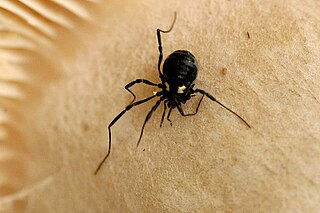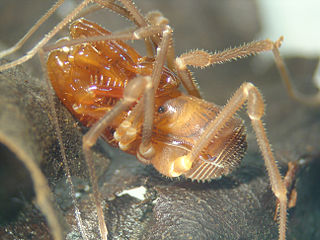
The Opiliones are an order of arachnids colloquially known as harvestmen, harvesters, harvest spiders, or daddy longlegs. As of April 2017, over 6,650 species of harvestmen have been discovered worldwide, although the total number of extant species may exceed 10,000. The order Opiliones includes five suborders: Cyphophthalmi, Eupnoi, Dyspnoi, Laniatores, and Tetrophthalmi, which were named in 2014.

The Phalangodidae are a family of harvestmen with about 30 genera and more than 100 described species, distributed in the Holarctic region.

The Sclerosomatidae are a family of harvestmen with about 1,300 known species. One former subfamily has been recently removed to form a new family, Globipedidae.

The Nemastomatidae are a family of harvestmen with about 170 described species in 16 recent genera. Several fossil species and genera are known.

The Ceratolasmatidae are a family of harvestmen with eleven described species.
The Stygnopsidae are a small family of harvestmen, with almost all species found in Mexico.
The Stygnidae are a family of neotropical harvestmen within the suborder Laniatores.
Agoristenidae are a neotropical harvestman family of the Suborder Laniatores, in the superfamily Gonyleptoidea.
The Manaosbiidae are a family of neotropical harvestmen within the suborder Laniatores.

The Cranaidae are a family of neotropical harvestmen within the suborder Laniatores.
Kimulidae is a small neotropical family of the harvestman infraorder Grassatores with about thirty described species.

Samoidae is a family of the harvestman infraorder Grassatores with about fifty described species.

The Cladonychiidae are a small family of harvestman with about 33 described species, within the suborder Laniatores.

Cryptocellus is an arachnid genus in the order Ricinulei, first described by John Westwood in 1874. It is native to the Neotropics.
Stygnomma spiniferum is a species of armoured harvestman in the family Stygnommatidae. It is found in North America.

Stygnomma is a genus of armoured harvestmen in the family Stygnommatidae. There are more than 30 described species in Stygnomma.









